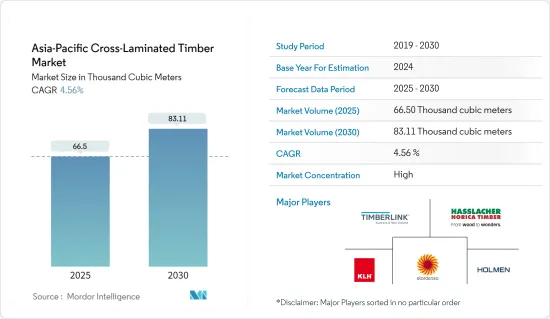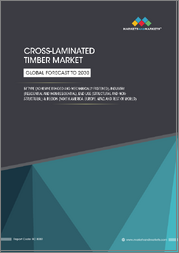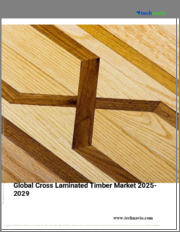
|
시장보고서
상품코드
1693967
아시아태평양의 직교 집성재(CLT) 시장 : 시장 점유율 분석, 산업 동향, 성장 예측(2025-2030년)Asia-Pacific Cross-Laminated Timber - Market Share Analysis, Industry Trends & Statistics, Growth Forecasts (2025 - 2030) |
||||||
아시아태평양의 직교 집성재(CLT) 시장 규모는 2025년에 6만 6,500 입방미터, 2030년에는 8만 3,110 입방미터에 달할 것으로 예상되며, 예측 기간(2025-2030년) 동안 4.56%의 연평균 복합 성장률(CAGR)을 보일 것으로 예측됩니다.

아시아태평양의 크로스 라미네이트 철근 시장은 코로나19의 악영향을 받았습니다. 엄격한 봉쇄 조치로 인해 산업 활동이 중단되었습니다. 그러나 규제 해제 후 순조롭게 회복되고 있습니다. 산업 활동의 성장은 아시아태평양의 크로스 라미네이트 철근 시장에 긍정적인 추세를 가져 왔습니다.
주요 하이라이트
- 단기적으로는 이 지역의 상업 부문의 성장이 시장 성장의 주요 요인으로 작용하고 있습니다.
- 그러나 재료의 수분 흡수 관련 위험은 예측 기간 동안 대상 산업의 성장을 억제할 것으로 예상되는 주요 요인입니다.
- 직교 집성재에 기반한 탄소 네거티브 미래는 가까운 미래에 세계 시장에서 유리한 성장 기회를 창출할 가능성이 높습니다.
- 중국은 다양한 용도로 국가 전체에서 이 소재가 상당히 많이 소비되고 있기 때문에 이 지역에서 가장 성장하는 시장으로 부상했습니다.
아시아태평양의 크로스 라미네이트 철근 시장 동향
시장을 독점하는 비주거용 부문
- 호텔, 사무실, 레스토랑 등 상업용 건물에서는 빔, 지지구조, 가구, 바닥, 벽, 천장 등 다양한 부분에 크로스 라미네이트 철근이 사용되어 실내에 미적 감각을 부여합니다.
- CLT(Cross Laminated Timber)(CLT)는 높은 강도 대 중량비, 간편한 시공, 미적 특성은 말할 것도 없고, 상대적으로 낮은 이산화탄소 배출량으로 인해 건축 건설에서 철골/콘크리트를 대체할 수 있는 혁신적인 재료로 등장했습니다.
- 최근 아시아태평양의 여러 기관에서 CLT(Cross Laminated Timber)가 사용되고 있습니다. 예를 들어, 호주에서는 올해 9월에 뉴캐슬 대학교의 새 건물에 CLT(Cross Laminated Timber)가 사용하기로 결정되었습니다. 이 프로젝트에는 약 5,800만 호주 달러(약 3,725만 달러)가 투입되며, 뉴사우스웨일즈 주 센트럴 코스트에 건설되는 최초의 대량 목재 사용 건물이 될 것입니다.
- 올해 싱가포르는 아시아에서 가장 유명한 머스탱바 건물인 난양공과대학교(NTU)의 난양 비즈니스 스쿨용 가이아 빌딩 건설에 투자했습니다. 이 프로젝트는 이토 토요오 건축설계사무소가 주도한 것으로, NTU의 스포츠 홀 '더 웨이브'에 이어 NTU 캠퍼스에서 두 번째로 마스트인바를 사용한 건물입니다.
- 또한, 필리핀 막탄 국제공항은 아시아 최초로 그루램으로만 지붕을 구성한 공항입니다. 글루램(Cross Laminated Timber)은 개별 목재를 조합하여 만든 구조재입니다. 이 목재는 높은 내구성과 내습성을 가지고 있으며, 일반적으로 멜라민이나 폴리우레탄 수지로 불리는 산업용 접착제로 결합하여 큰 조각이나 독특한 형태를 쉽게 만들 수 있습니다.
- 따라서 상업용 건물의 건설이 증가함에 따라 벽, 지붕, 바닥, 천장에 대한 수요도 크게 증가하여 아시아태평양 국가에서 크로스 라미네이트 철근의 큰 시장을 형성하고 있습니다.
시장을 독점하는 중국
- 중국은 세계 최대의 목재 수입국입니다. 중국 경제의 급속한 발전과 함께 목재 부문도 변모하고 현대화가 진행되고 있습니다. 중국 목재 및 목재 제품 협회에 따르면 중국은 세계 최대 목재 및 목재 제품 소비국으로 연간 5억 7,000만 m3의 목재를 소비하고 있으며, 이 중 3억 1,000만 m3의 수입 목재(RWE)를 포함합니다.
- 2022년 중국은 침체된 부동산 개발을 되살리고 개발업체들의 자금 부족에서 회복을 돕기 위해 여러 가지 이니셔티브를 시작했습니다. 그러나 연말의 새로운 조사에 따르면 국내 교착상태에 빠진 프로젝트 중 21%만이 완전히 건설을 재개한 것으로 나타났습니다.
- 중국 정부는 전체 경제 성장을 가속하기 위해 국내 건설 부문 전체에 대한 투자 촉진에 주력하고 있습니다. 예를 들어, 인프라 건설에 대한 대출을 늘리기 위한 최근의 움직임은 정책은행의 대출 비율을 1,200억 달러까지 끌어올리는 것을 포함합니다. 정부는 또한 지방정부가 인프라 건설 자금을 조달할 수 있도록 특별공채 한도 중 최대 약 2,200억 달러를 지방정부가 사용할 수 있도록 하는 방안도 검토하고 있습니다.
- 건설 산업의 부가가치는 2023년 6% 성장하여 8조 7,500억 위안(1조 2,000억 달러)에 달했습니다. 상업용 부동산 건설은 인프라 프로젝트 착공에 따라 성장할 것으로 예상되지만, 주택 건설은 2023년에 거의 성장하지 않았습니다.
- 2023년 8월, 3개의 학교와 1개의 병원 프로젝트 건설이 새로운 단계에 접어들었습니다. 베이징은 3개의 학교와 1개의 병원을 건설하여 새로운 지역을 돕고 있습니다.
- 이러한 조치들이 예측 기간 동안 국내 건설 산업을 견인할 것으로 예측됩니다. 이는 건설 산업에서 연구되는 시장 수요에 박차를 가할 것으로 보입니다. 정부는 또한 코로나19로부터의 회복 후 국가의 경제적 영향에서 벗어나기 위해 건설 부문, 특히 인프라 부문의 활동을 촉진하고자 합니다.
- 따라서 앞서 언급한 요인들은 예측 기간 동안 해당 국가에서 조사된 시장 수요에 영향을 미칠 것으로 예측됩니다.
아시아태평양의 크로스 라미네이트 철근 산업 개요
아시아태평양의 직교 집성재 시장은 소수의 주요 업체들이 시장을 주도하고 있으며, 통합된 성격을 가지고 있습니다. 주요 기업(무순)으로는 Stora Enso, Timberlink Australia & New Zealand, KLH Massivholz GmbH, HASSLACHER Holding GmbH, Holmen 등이 있습니다.
기타 혜택
- 엑셀 형식 시장 예측(ME) 시트
- 3개월간 애널리스트 지원
목차
제1장 서론
- 조사의 전제조건
- 조사 범위
제2장 조사 방법
제3장 주요 요약
제4장 시장 역학
- 성장 촉진요인
- 성장 억제요인
- 산업 밸류체인 분석
- Porter의 Five Forces 분석
- 공급 기업의 교섭력
- 소비자의 교섭력
- 신규 진출업체의 위협
- 대체품의 위협
- 경쟁 기업간 경쟁 관계
제5장 시장 세분화
- 유형
- 접착제
- 기계적 고정
- 용도
- 주택용
- 비주택용
- 상업용
- 산업/시설
- 기타
- 지역
- 중국
- 인도
- 일본
- 한국
- 기타 아시아태평양
제6장 경쟁 구도
- 인수합병(M&A)/합작투자(JV)/협업/협정
- 시장 순위 분석
- 주요 기업의 전략
- 기업 개요
- AGROP NOVA a.s.
- HASSLACHER Holding GmbH
- Holmen
- KLH Massivholz GmbH
- Mercer International Inc.
- SCHILLIGER HOLZ AG
- SEIHOKU CORPORATION
- Stora Enso
- Timberlink Australia & New Zealand
- XLam Australia Pty Ltd
제7장 시장 기회와 향후 동향
LSH 25.05.21The Asia-Pacific Cross-Laminated Timber Market size is estimated at 66.50 thousand cubic meters in 2025, and is expected to reach 83.11 thousand cubic meters by 2030, at a CAGR of 4.56% during the forecast period (2025-2030).

The Asia-Pacific cross-laminated timber market was negatively impacted by COVID-19. The implementation of stringent lockdown measures led to a halt of industrial operations. However, the sector has been recovering well since restrictions were lifted. The growth in industrial activities registered a positive trend for the cross-laminated timber market in the Asia-Pacific region.
Key Highlights
- Over the short term, growing commercial sectors in the region are the major factor driving the growth of the market studied.
- However, moisture absorption-related risks of the material are the key factors anticipated to restrain the growth of the target industry over the forecast period.
- Nevertheless, the carbon-negative future based on cross-laminated timber is likely to create lucrative growth opportunities for the global market soon.
- China emerged as the largest growing market for cross-laminated timber in the region owing to considerable consumption of the material across the country for various applications.
Asia-Pacific Cross-Laminated Timber Market Trends
Non-Residential Application Segment to Dominate the Market
- In commercial buildings such as hotels, offices, and restaurants, cross-laminated timber is used in various parts, including beams, support structures, furniture, floors., walls, ceilings, and other such areas, giving the rooms an aesthetic appearance.
- Cross-laminated timber (CLT) has emerged as an innovative alternative material to steel/concrete in building construction, given its relatively low carbon footprint, not to mention its high strength-to-weight ratio, simple installation, and aesthetic features.
- Cross-laminated timber has recently been used in various institutions in the Asia-Pacific. For instance, in Australia, the University of Newcastle's new building was set to be made using cross-laminated timber in September this year. The project cost around AUD 58 million (~ USD 37.25 million) and would be the first mass timber building constructed on the NSW Central Coast.
- This year, Singapore made an investment in the construction of Asia's most prominent mass timber building: the Gaia building for the Nanyang Business School at Nanyang Technological University (NTU). This project has been led by Toyo Ito & Associates, and is the second building on the NTU campus to use mass timber, following NTU's 'The Wave' sports hall.
- The Mactan International Airport in the Philippines is Asia's first airport with a roof structure composed entirely of glulam. Glulam (Glued Laminated Wood) is a structural material produced from the union of individual wood segments. This wood has high durability and humidity resistance, making it easy to make big pieces and unique shapes when binding with industrial adhesives commonly known as melamine or polyurethane resin.
- Therefore, with such a rise in the construction of commercial buildings, the demand for walls, roofs, floors, and ceilings has also increased substantially, thus creating a significant market for cross-laminated timber in the Asia-Pacific countries.
China to Dominate the Market
- China operates as the world's largest importer of timber. As China's economy continues to develop rapidly, the timber sector is also in a state of transformation and modernization. Furthermore, as per the Chinese Timber and Wood Products Association, China is the world's biggest consumer of timber and timber products, with an annual consumption of 570 million m3 of timber, including 310 million m3 of imported timber (RWE).
- In 2022, China launched several initiatives to revive stalled property developments and help developers recover from a funding shortage. Still, at year-end, a new survey showed that only 21% of the country's stalled projects had completely resumed construction.
- The Chinese government is focusing on boosting investments across the construction sector in the country to boost overall economic growth. For instance, recent moves to increase financing for infrastructure construction include a USD 120 billion increase in the lending ratio of policy banks. The government is also considering allowing local governments to spend up to about USD 220 billion of the special bond quota through which local governments fund infrastructure construction.
- The value-added of the construction industry is expected to grow by 6% in 2023, reaching CNY 8.75 trillion (USD 1.2 Trillion). The growth of commercial property construction is expected to increase, with infrastructure projects starting, while residential property construction is projected to show little growth in 2023.
- In August 2023, the construction of 3 schools and one hospital project entered a new phase. Beijing is aiding the new area by building three schools and one hospital.
- These policies are expected to drive the nation's construction industry over the forecast period. This will likely spur the demand for the market studied in the construction industry. The government is also looking forward to boosting activities in the construction sector, more specifically in the infrastructure sector, after the recovery from COVID-19 to bounce back from the country's economic impact.
- Thus, the aforementioned factors are expected to impact the market's demand studied in the country during the forecast period.
Asia-Pacific Cross-Laminated Timber Industry Overview
The Asia Pacific cross-laminated timber (CLT) market is consolidated in nature, with few key players leading the studied market. The major players (not in any particular order) include Stora Enso, Timberlink Australia & New Zealand, KLH Massivholz GmbH, HASSLACHER Holding GmbH, and Holmen.
Additional Benefits:
- The market estimate (ME) sheet in Excel format
- 3 months of analyst support
TABLE OF CONTENTS
1 INTRODUCTION
- 1.1 Study Assumptions
- 1.2 Scope of the Study
2 RESEARCH METHODOLOGY
3 EXECUTIVE SUMMARY
4 MARKET DYNAMICS
- 4.1 Drivers
- 4.1.1 Growing Commercial Sector in the Region
- 4.1.2 Increasing Popularity of Cross-Laminated Timber Over other Traditional Wood Materials
- 4.2 Restraints
- 4.2.1 Moisture Absorption Related Risks of the Material
- 4.2.2 Other Restraints
- 4.3 Industry Value Chain Analysis
- 4.4 Porter's Five Forces Analysis
- 4.4.1 Bargaining Power of Suppliers
- 4.4.2 Bargaining Power of Consumers
- 4.4.3 Threat of New Entrants
- 4.4.4 Threat of Substitute Products and Services
- 4.4.5 Intensity of Competitive Rivalry
5 MARKET SEGMENTATION (Market Size in Volume)
- 5.1 Type
- 5.1.1 Adhesive Bonded
- 5.1.2 Mechanically Fastened
- 5.2 Application
- 5.2.1 Residential
- 5.2.2 Non-Residential
- 5.2.2.1 Commercial
- 5.2.2.2 Industrial/Institutional
- 5.2.2.3 Other Applications
- 5.3 Geography
- 5.3.1 China
- 5.3.2 India
- 5.3.3 Japan
- 5.3.4 South Korea
- 5.3.5 Rest of Asia-Pacific
6 COMPETITIVE LANDSCAPE
- 6.1 Mergers and Acquisitions, Joint Ventures, Collaborations, and Agreements
- 6.2 Market Ranking Analysis
- 6.3 Strategies Adopted by Leading Players
- 6.4 Company Profiles
- 6.4.1 AGROP NOVA a.s.
- 6.4.2 HASSLACHER Holding GmbH
- 6.4.3 Holmen
- 6.4.4 KLH Massivholz GmbH
- 6.4.5 Mercer International Inc.
- 6.4.6 SCHILLIGER HOLZ AG
- 6.4.7 SEIHOKU CORPORATION
- 6.4.8 Stora Enso
- 6.4.9 Timberlink Australia & New Zealand
- 6.4.10 XLam Australia Pty Ltd
7 MARKET OPPORTUNITIES AND FUTURE TRENDS
- 7.1 Carbon-negative Future Based on Cross-laminated Timber



















